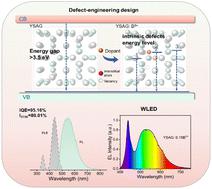用于高效单组分 pc-WLED 的新型超宽带可见光石榴石荧光粉
IF 5.3
2区 材料科学
Q2 MATERIALS SCIENCE, MULTIDISCIPLINARY
引用次数: 0
摘要
开发超宽带可见光发射荧光粉对于实现具有更好色彩体验的下一代照明至关重要。本文提出了一种以结构阳离子置换为介导的缺陷工程策略,并通过实验证明了石榴石荧光粉的特定超宽带发射。通过晶格畸变诱导的氧空位和间隙阳离子打破了晶体的周期势场,提供了带隙中的电子水平。因此,在蓝光发光二极管的激发下,新型 Y3Sc2Al3O12:B3+ 显示出超宽的发射,半最大值全宽(FWHM)达到 ∼ 170 nm。与一般的缺陷发光荧光粉相比,独特的 Y3Sc2Al3O12:B3+ 具有优异的抗热淬性能和高达 95% 的内部量子效率。这些发现不仅显示了 Y3Sc2Al3O12:B3+ 作为一种超宽带发光体的巨大前景,而且还提供了一种新的设计策略,即在单组分材料中实现白光应用中的全可见光谱荧光粉。本文章由计算机程序翻译,如有差异,请以英文原文为准。

A novel extra-broadband visible-emitting garnet phosphor for efficient single-component pc-WLEDs
The development of extra-broadband visible emission phosphors is crucial to achieve next-generation illumination with better color experience. Herein, a defect engineering strategy mediated by the structural cationic substitution is proposed and experimentally demonstrated for specific ultra-broadband emission in a garnet phosphor. The induced oxygen vacancies and interstitial cation through lattice distortion break the periodic potential field of the crystal and provide electronic levels in the band gap. As a result, excited by blue-light-emitting diodes, the novel Y3Sc2Al3O12:B3+ shows an ultra-broad emission with a full width at half maximum (FWHM) of ∼170 nm. Compared to general defect-emitting phosphors, the unique Y3Sc2Al3O12:B3+ exhibits excellent thermal quenching resistance and superior internal quantum efficiency of up to 95%. These findings not only show great promise of Y3Sc2Al3O12:B3+ as an extra-broadband emitter but also provide a new design strategy to achieve a full-visible-spectrum phosphor in a single-component material for white-light applications.
求助全文
通过发布文献求助,成功后即可免费获取论文全文。
去求助
来源期刊

ACS Applied Nano Materials
Multiple-
CiteScore
8.30
自引率
3.40%
发文量
1601
期刊介绍:
ACS Applied Nano Materials is an interdisciplinary journal publishing original research covering all aspects of engineering, chemistry, physics and biology relevant to applications of nanomaterials. The journal is devoted to reports of new and original experimental and theoretical research of an applied nature that integrate knowledge in the areas of materials, engineering, physics, bioscience, and chemistry into important applications of nanomaterials.
 求助内容:
求助内容: 应助结果提醒方式:
应助结果提醒方式:


